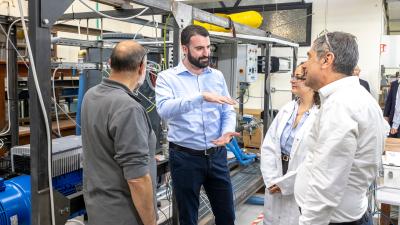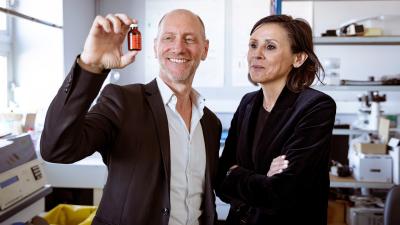Tonio Sant, Daniel Buhagiar and team
Next-gen energy storage for offshore wind farms
The European Green Deal calls for a 55% reduction in greenhouse gas emissions by 2030. Scaling up offshore wind capacity is central to meeting the target, but this renewable source is vulnerable to intermittent winds.
The FLASC system offers a cheaper, reliable way of storing wind energy on a large scale. It can capture and store excess energy during high winds to generate electricity when needed. Two Pressure Vessel Bundles (PVBs) are connected through an umbilical cable. The lower PVB is secured to the seabed, and the upper is housed within a floating support structure. The lower PVB converts the excess wind-generated electricity into energy by compressing air using pressurised seawater as a liquid piston inside high-pressure reservoirs. During times of low wind, customer demand can be met by reversing the process to release the stored energy and generate electricity via a turbine.
The lower PVB increases the system’s storage capacity and regulates the temperature, which rises as the liquid is pressurised and cools as the pressure is released. FLASC, being underwater, can use the ocean as a natural heat sink without a complex thermal management system.
Buhagiar was inspired by his home country, where land usage is at a premium, “It's very difficult to find a space to do something, so the idea was simple. What if we could have an energy storage system that is co-located within the wind farm offshore using the same footprint?”
Scaling up renewable energy sources
FLASC was developed during Buhagiar’s PhD in offshore wind, hydraulic transmission and energy storage at the University of Malta. Supervised by Sant, a professor of wind energy, offshore renewables and energy storage, the system was created as an academic challenge, rather than a solution to a problem. The university recognised the potential of their work and encouraged the duo to patent protect their invention and supported them through the process.
Their system has the potential to stabilise the energy supply from multiple offshore wind farms. Studies have shown that it allows 93% of all energy stored to be recovered, even in shallower waters and with a minimal seabed footprint. Enabling excess energy storage unlocks further potential for offshore wind - it's estimated that for every gigawatt of offshore wind energy produced, 3.5 metric tons (Mt) of CO2 coal emissions and 1.6 Mt of CO2 natural gas emissions are displaced every year.
For Sant, the key to progress is ideas, “The best skill is the ability to come up with new ideas that have a positive social impact… particularly for engineers, because we apply science for the common good of society.”
Media gallery
Press materials
Access materials for journalists
Press release: Next-gen energy storage for offshore wind farms: Maltese engineers selected as finalists for the European Inventor Award 2024 Press photos Video (MP4): English Video (MP4): Maltese(for MXF format videos or transcripts, please contact press@epo.org)
Contact
European Inventor Award and Young Inventors Prize queries:
european-inventor@epo.org Subscribe to the European Inventor Award newsletterMedia-related queries:
Contact our Press team#InventorAward #YoungInventors





